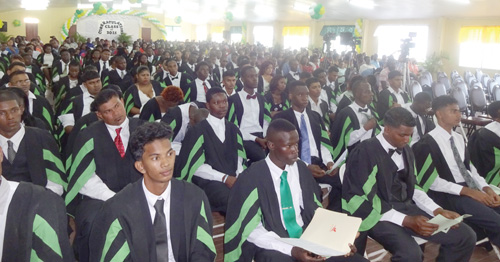The Guyana School of Agriculture was established to satisfy a need for a National Agricultural Training Institution in Guyana. This idea was the brain child of Dr. Cheddi Jagan, the then Premier of British Guiana.
The School began on September 09, 1963 at Mon Repos, East Coast Demerara eleven (11) miles from Georgetown. The first enrollment comprised of twenty-five (25) male students. In that period the Central Agriculture Station (CAS) compound consisted of five dwelling houses which provided facilities for classrooms, dormitories and cafeteria.
The first Principal was Mr. Harry Madramootoo, Director of Research of the British Guiana Rice Board. Lectures were supplied by the Ministry of Agriculture on a part-time basis.
In 1964, the school became a state corporation. The Minister of Agriculture then appointed a Board who would formulate policies which will direct operations.

Brief history
Guyana School of Agriculture (GSA) was established in the year 1963 by former President Dr. Cheddi Jagan offering the Diploma in Agriculture and the Certificate in Agriculture Programmes. The first batch of 15 students graduated in 1966.
In 1994 the Certificate in Forestry Programme was introduced, followed by the introduction of the Animal Health and Veterinary Public Health Programme in 2007 and the Certificate in Fisheries Studies Programme in 2008. In 2013 the Food Science and Technology programme was introduced. Over the years, the school graduated 3,060 professionals in different fields of agriculture and forestry thereby, addressing technical capacity building through the development of skills and capacities. Also, enhanced knowledge and information exchange between, the actors involved in innovation. This included farmers and their organizations, agricultural research, education and training institutions, extension and advisory services institutions, and the researchers and professionals working in the agricultural sector of Guyana and the Caribbean.
Both the immediate past and current principals agree that the greatest contribution GSA has made to Guyana’s development and to a lesser extent regional development was to provide significant human resources. This aided in supporting the agricultural sector which is still the mainstay of our economy. They point to the fact that over the past 40 years, GSA has produced 2,328 graduates 465 of whom are women, 153 are foreign students, four of whom are from Africa. It was said that these graduates are the backbone of Guysuco, the Ministry of Agriculture; the staff of the Faculty of Agriculture of the University of Guyana and they are employed in other regional and international organisations.

2015 Graduation | 138 Graduates
Objectives of GSA
The objectives of the school were outlined as follows:-
- To offer theoretical and practical training in Agriculture.
- To develop, manage and operate farms and undertakings of an agricultural nature, i.e. to operate commercial farms and undertakings in accordance with good farming practice.
Mission Statement
“To promote and support agricultural development through education and training of young men and women interested in an agricultural career.”
Entry Requirements
The school offers a two-year sub-professional Diploma. Its admission requirements are 4 subjects GCE or CXC including English, and at least one science subject. A sound basic primary education is the requirement for admission to the Certificate programme. It has a strong practical bias and is intended mainly for youths. The school is run by a board appointed by cabinet on the recommendation of the Ministry of Agriculture. The Principal and a member of the board head the team which is responsible for the day to day management of the school.
Part Of The Grand Plan “to feed, clothe and house the nation”

2012 Graduation Class | 113 Graduates
With an emphasis on self-sufficiency, within seven years of the establishment of the GSA, Guyana became a republic espousing the ideology of “Cooperative Socialism”. In its 1972-1976 development plan, the government declared its intention “to feed, clothe and house the nation”. Import substitution, buying local and growing more food were the main strategies to achieve these goals. It was clear from the resources invested in its development that the GSA was to play an important role in helping to achieve those goals. In 1970, GSA’S farming activities were limited to market gardening on a fifteen-acre plot and a livestock farm. By 1980, the school had 47 acres under rice, a 50-acre orchard at Kurukururu and a small carambola orchard at Mon Repo,s in addition to the original market gardening plot. Significant resources were invested in a Food Processing Unit which served both as a teaching and semi commercial agency.
There were also significant increases in student enrollment and numbers of graduates. In 1970, 32 students were enrolled in the Diploma programme, by 1980 that number had increased to 133. Between 1963 and 1970 there were 92 graduates from the Certificate course and 71 from the Diploma course. Between 1971 and 1980 that number had increased to 173 and 455 respectively. The larger number of graduates from the Diploma course reflected a growing need for middle level personnel trained in the field. Several of the graduates were nationals from other Caricom countries who returned home to Grenada, St. Vincent, St. Lucia and Montserrat to serve. Like the rest of Guyana.
The Guyana School of Agriculture provides for those individuals interested in Agriculture so they can be well skilled in those areas and better serve the needs of the economy.
General Contact Information
Mon Repos
- GUYANA SCHOOL OF AGRICULTURE CORPORATION MON REPOS, EAST COAST DEMERARA Telephone No. 220 – 2297 Fax: 220 – 8955 E-mail: [email protected]
Essequibo Branch
- GUYANA SCHOOL OF AGRICULTURE CORPORATION ESSEQUIBO BRANCH – Cotton Field, Essequibo Coast. Reg. 2. Telephone No: 771-1387 E-mail: [email protected]
References
Discover more from Things Guyana
Subscribe to get the latest posts sent to your email.







